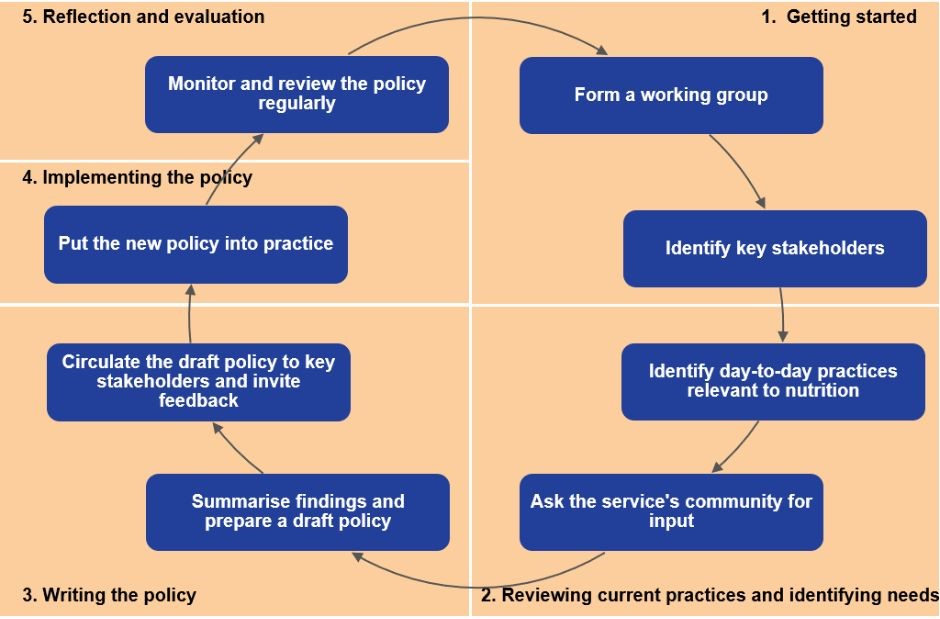Developing a healthy eating policy
A healthy eating policy provides staff, carers, parents and families with clear and consistent information about your service’s goals and practices around nutrition and healthy eating for children.

Developing a healthy eating policy will assist your service to:
- Support children to meet their nutritional requirements, in line with the Australian Dietary Guidelines and Infant Feeding Guidelines
- Meet the requirements of the National Regulations 168 and 170
- Maintain consistent standards and procedures around food and nutrition
- Ensure that the food and drinks provided are safe
- Provide opportunities for learning and socialising at mealtimes
- Guide the planning of your service’s menu
- Demonstrate leadership and commitment to healthy eating
- Enhance and promote your reputation as a high quality service
- Meet the healthy eating and oral health benchmarks of the Achievement Program
- Ensure that any positive changes to food and eating practices are sustained in the long term
- Assess and evaluate your performance against pre-determined goals and identify areas which may need improvement.
How do you develop a nutrition and healthy eating policy?
Writing a nutrition and healthy eating policy does not need to be difficult. Your service may already have a policy or a number of unwritten rules about food and eating that will form the basis of your policy.
Work through the steps in each of the stages on the following pages to help you develop or review a policy that reflects the food and nutrition goals and practices of your service.
Stage 1. Getting started
Form a working group
This group will work together to develop a new policy, or review your existing one. The working group should include a coordinator as well as key stakeholders (see below). The group should decide on goals and strategies for the policy as well as a timeline to work by.
Identify key stakeholders
A variety of key stakeholders should be invited to join the working group. These are likely to include parents, families, the centre director or coordinator, cook, staff and carers and early childhood or healthcare professionals.
Involving staff and families in policy planning is important to ensure they understand their role in implementing the policy and will support it once it is put into practice. Consulting a nutrition professional can help ensure the policy has the appropriate nutrition emphasis. Contact the Healthy Eating Advisory Service on 1300 22 52 88 or email heas@nnf.org.au for advice from our experienced nutritionists and dietitians. Remember: Children are also important stakeholders who need to be considered, even if they cannot officially take part in a working group.
Stage 2. Reviewing current practices and identifying needs
Identify day-to-day practices relevant to food and nutrition
If your child care service currently has a food and nutrition policy, review it to see if it aligns with the requirements upon which the working group has decided.
Ask the service’s community for input
Inform all staff and families that a nutrition and healthy eating policy is being developed and provide an opportunity for everyone to contribute.
Stage 3. Writing the policy
Summarise findings and prepare a draft policy
Use the Healthy Eating Advisory Service’s checklist, ‘What to include in a nutrition and healthy eating policy’ [3], as well as other relevant resources to develop an agreed picture of what makes an ideal health promoting food and nutrition service for early childhood services.
Resources to consider may include:
- Australian Dietary Guidelines [1]
- Infant Feeding Guidelines [2]
- National Quality Standard for Early Childhood Education and Care Food allergy and intolerance [4]
- Menu planning guidelines for long day care [5]
- Get Up and Grow: Healthy eating and physical activity for early childhood [6]
- Achievement Program resources
Using this information, draft a policy document that is clear and easy to follow. Be sure to include any requirements prescribed by state or national licensing and accreditation authorities.
Circulate the draft policy to key stakeholders and invite feedback
Invite staff and families to comment on the draft policy before it is put into practice. Make any necessary changes according to the feedback received.
Stage 4. Implementing the policy
Put the new policy into practice
Inform all staff, parents and families about the new policy and display it in clear view. Make any changes required according to the goals and strategies set out in the policy document, and ensure that your service is now operating according to each of the policy statements. Some training and professional development or dedicated work time may be required to assist staff members in implementing some of the changes. Identify any practices that are not consistent with the policy, as well as any barriers. Work out ways to overcome the barriers in order to put the policy into practice.
Stage 5. Reflection and evaluation
Monitor and review the policy regularly
It is a good idea to monitor any changes that have been made in your service due to the new policy. It is also important to determine whether or not the policy is able to meet the short and long term goals set and whether families, staff and children are satisfied with the policy. A yearly review can help you ensure that the policy is up-to-date and relevant; and that practices in your early childhood service remain consistent with the policy. The policy may need to be changed from time–to-time to include new information or improvements.
References
[1] Australian Dietary Guidelines, National Health and Medical Research Council, 2013, www.eatforhealth.gov.au
[2] Infant Feeding Guidelines, National Health and Medical Research Council, 2013
[3] What to include in a nutrition and healthy eating policy, Healthy Eating Advisory Service, Department of Health and Human Services, State Government of Victoria, 2013, www.heas.health.vic.gov.au
[4] Food allergy and intolerance, Healthy Eating Advisory Service, Department of Health and Human Services, State Government of Victoria, 2014, www.heas.health.vic.gov.au
[5] Menu planning guidelines for long day care, Healthy Eating Advisory Service, Department of Health and Human Services, State Government of Victoria, 2012, www.heas.health.vic.gov.au
[6] Get Up & Grow: Healthy Eating and Physical Activity for Early Childhood, Commonwealth of Australia, 2009
For more information please phone 1300 22 52 88 or email heas@nnf.org.au
Except where otherwise indicated, the images in this document show models and illustrative settings only, and do not necessarily depict actual services, facilities or recipients of services. This document may contain images of deceased Aboriginal and Torres Strait Islander peoples. In this document, ‘Aboriginal’ refers to both Aboriginal and Torres Strait Islander people. ‘Indigenous’ or ‘Koori/Koorie’ is retained when part of the title of a report, program or quotation. Copyright © State of Victoria 2016
Written and reviewed by dietitians and nutritionists at National Nutrition Foundation, with support from the Victorian Government.

Featured recipes
Explore all recipes
Register your interest
"*" indicates required fields















